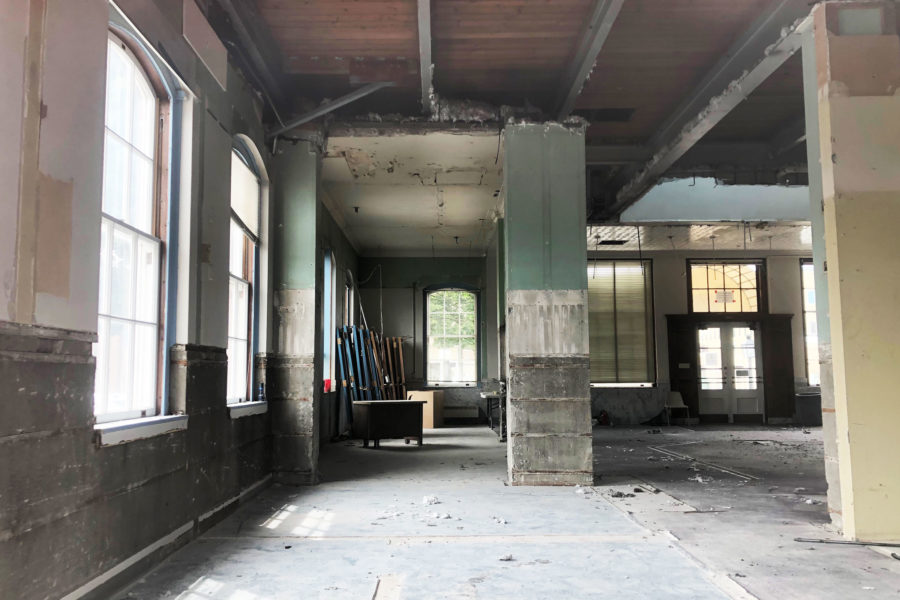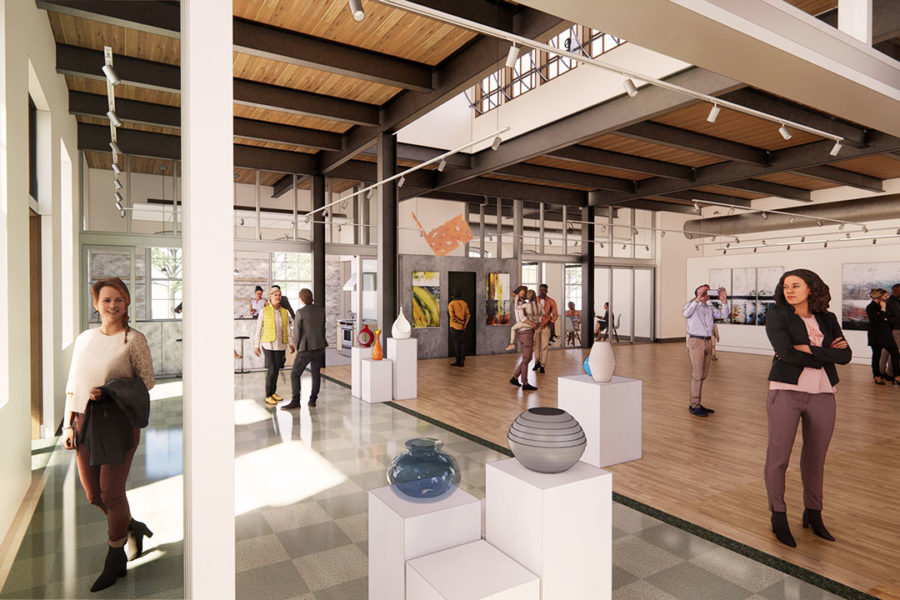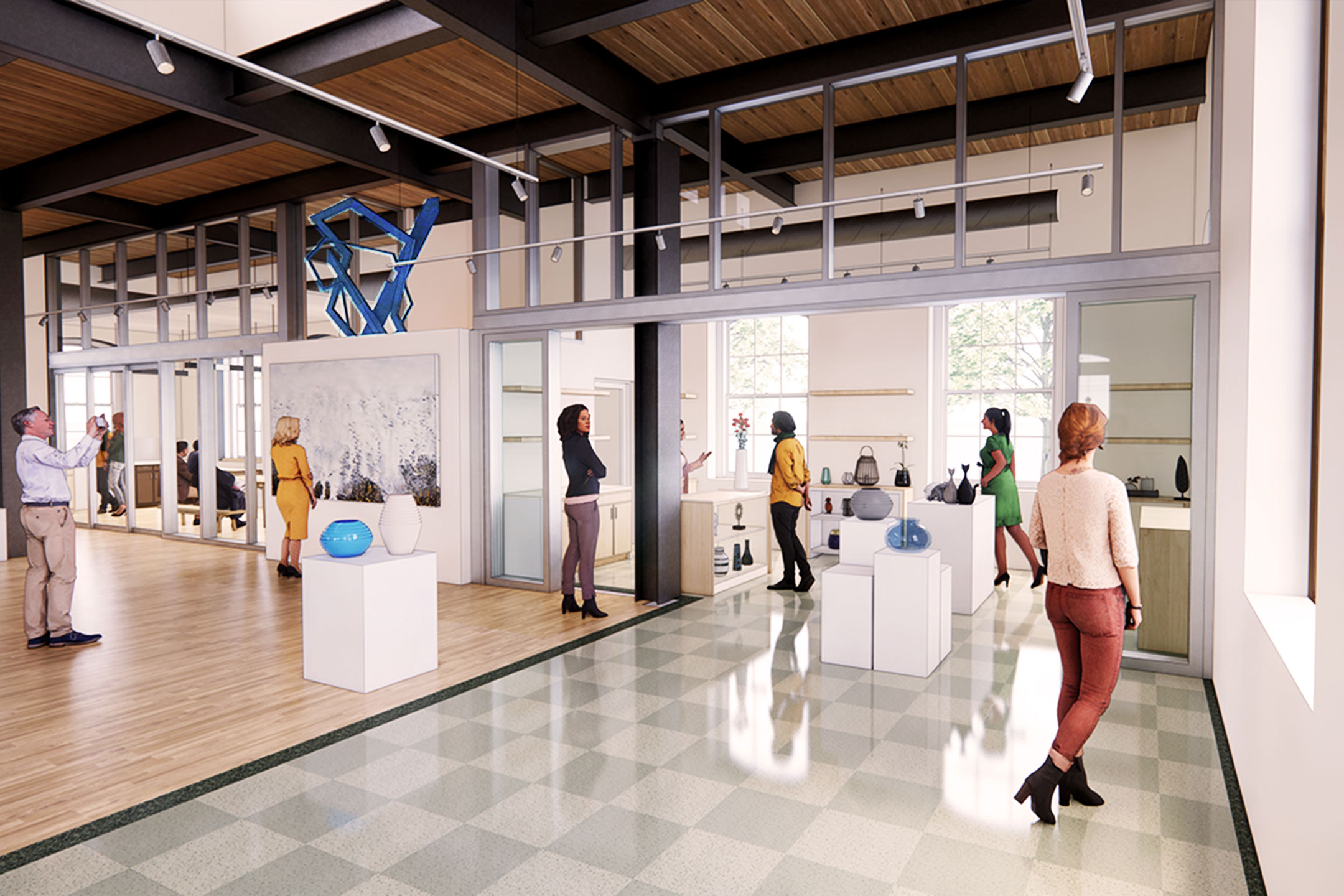Story at a glance:
- A former post office is being transformed into an arts center in Washington state.
- The adaptive reuse project builds on the circa 1939 building’s “good bones.”
- The team uncovered beautiful details as well as big challenges along the way.
In a growing arts district in Auburn, Washington, a former post office is being reimagined as a destination and an anchor—revitalizing the community’s downtown area.
Community members of the western Washington city came together to acquire and restore their 1939 post office with the intent to create a downtown center for the arts. The building is adjacent to an aging dinner theater that’s also part of the area’s revitalization.
Over the last eight decades the facility has seen many uses—from post office to public health center. This time the community envisioned a gallery and support spaces for local artists, theater groups, and area arts organizations.
Initial Assessment
The City of Auburn and the Auburn Parks Department started with a question: What was possible? That led our team at Johnston Architects (JA) to begin efforts to analyze the building’s condition. Some elements, like the cupola, were deteriorating, while others were simply missing, like an entry canopy. The old wood sash windows were in desperate need of repair and the interior floors were concealed under musty carpet.
But the quality of the spaces within the facility was excellent. Like many governmental buildings of its time, the Auburn Post Office was built to withstand just about anything. The basement walls, foundation, and floor system were made of concrete. The ground-level walls are made of un-reinforced masonry, and the roof system is a composite of steel and wood supported by substantial steel columns. The bones, as they say, were very good—a perfect project for the principles of sustainability and cultural preservation of adaptive reuse to shine.
Despite deep community interest and an inspiring vision, like many historic renovations, funding for the project accrued incrementally. After completing our conditions analysis, JA was asked to study the feasibility of inserting an art gallery program into the existing facility. Initial funding allowed for a small budget to cover the development of as-built drawings (especially complex in a building of this age that has been altered over time), minor repairs to keep the building safe, and selective demolition in order to assess and document the basic building systems, such as electrical, mechanical, and perhaps most importantly, structural. Vital to the long-term planning of the project, this initial demolition allowed the design team to recognize the potential in further emphasizing the building’s structure and giving its original materials new life.
What We Found Along the Way

Before. Photo courtesy of City of Auburn
Above a 20-year-old acoustic ceiling, contractors discovered a beautiful tongue-and- groove wood ceiling supported by a grid of substantial steel girders and purlins. They also found that the HVAC system was well past its useful life and needed to be replaced. The presence of asbestos and lead paint required further demolition and careful remediation.
When the contractors departed, Auburn officials and the design team met to survey their work. What we walked into was a light-filled, well-proportioned space with east-facing clerestory windows at the entrance, original wood and terrazzo floors over a concrete structure, and a dramatic wood and steel ceiling system.
Also uncovered during demolition was a large security vault near the middle of the space—essentially an impenetrable concrete box with steel doors—that was originally adjacent to the postmaster’s office. The design team opted to save the vault from demolition and leave it in place with minimal intervention so its distinctive history will be on display as both an interesting design relic and a unique gallery space.
Next Steps for Renovation

Rendering courtesy of Johnston Architects
As JA worked with the City of Auburn to determine the next moves, small renovation grants allowed for contractors to rebuild window sashes to save the building from additional deterioration and carefully remove and store the Alaskan marble wainscot for future reuse in the space.
In further demolition of the plaster-covered brick walls, we realized a layer of asphaltic solution had been applied to the interior bricks, making it impossible to restore and expose those elements as we had intended to. We didn’t have everything we had first imagined we would, but what we had was enough. Acknowledging the unpredictable nature of adaptive reuse, our design was shaped by the unexpected.
Working with City of Auburn, JA developed a design that inserted walls to address the gallery programming needs. The first phase, which includes the main floor, is dominated by gallery spaces and artist-in-residence studios. Additionally, a gift shop will serve as a revenue generator, allowing local artists an opportunity to promote and sell their work. A catering kitchen or café will strengthen the vision of the Auburn Arts Center as a community event space for gallery openings, fundraisers, and educational events.
Sustainable Features
The new HVAC system and ductwork was designed to be purposely exposed and thus participate in the character of the reimagined space. The new system supplies heating, cooling, and ventilation through an efficient electric heat pump, significantly improving the sustainability of the building and supporting the climate control required in an arts space.
Additional sustainability measures include maintaining the existing steel structure, adding insulation to enhance the energy efficiency of the building envelope, replacing some of the windows with new ones with higher insulation value, and use of sustainable processes and products in the design.
One such product is an adjustable, high-efficiency LED lighting system that’s specifically designed to illuminate artwork. A thoughtful audiovisual component will also allow for maximum flexibility of the space to host multimedia art installations and community events. lending to a more sustainable future.
More Details
The airy feel of the new interior elements contrasts beautifully with the materiality of the original, heavy masonry building and its now-exposed, rather muscular steel structure.
The inspiring, light-filled space that first enraptured the team remains intact and welcomes visitors upon entry with glass walls dividing the flanking spaces from the open, double-height gallery. Storage space has been planned for the back of the gallery, providing a place to tuck away event furniture. This storage solution is also home to several portable display walls. These 8-by-8-foot wall assemblies are designed on castors and able to be configured to fit any mix of art show curated.
Demolition of interior partitions in the building’s basement level revealed an open, flexible space to meet future needs of the community. With concrete walls, floor, and ceiling, the basement has two exit paths (one of which is ADA accessible), which allows us to consider a mix of uses for the space. The team is currently considering teaching spaces for community-based art classes, active arts processes like a pottery or glass studio, performance rehearsal spaces, and additional offices. This full remodel will evolve as funding becomes available.
Of course, at 83 years old, the interior of this historic post office was not the only part that needed restoration work. The building envelope was in relatively good shape, but exterior restoration was required while keeping the classical architecture preserved. Additional insulation and a new roof were called for to improve the building’s energy efficiency and minimize its long-term environmental impact.
An arched fabric awning, installed in the 1960s when the building was used as a public health center, currently obscures the transom windows above the front door and is not in keeping with the age and style of the building. A new entry canopy will reflect the original intent of the designers and fit more closely with the age and style of the building.
The original, decorative glass cupola with metal spire was rusting and in need of refurbishing. Soon the cupola base will undergo necessary repairs and the cupola cap will be replaced with a copper spire, which will once again be an internally illuminated “beacon” anchoring the prominent downtown corner in Auburn.
The City of Auburn vacated the alley between the new center and the older dinner theater building, meaning the space can be used for gatherings and pedestrian traffic. Against the refurbished building will be an all-weather stage and small lawn to host outdoor performances, further strengthening the community’s connection to its natural environment and encouraging healthy outdoor activity.
The adaptive reuse of this historic building is a relevant example of how developers, facilities directors, and designers can repurpose our communities’ older building stock to revitalize town centers, strengthen civic pride, and support future generations. Not only did the historic structure itself provide inspiration during the iterative design process, preventing its demolition extended its life cycle and lightens its environmental footprint over time. The challenges presented by transforming the existing space were offset by the rewards of a more sustainable solution that retains the embodied carbon energy of the original building while producing a more energy-efficient space for the city to maintain over time.
The energetic tension between the historic and modern elements lends itself to the building’s new use, celebrating and supporting the arts in the Auburn community. Beyond the practicalities of keeping existing materials and structures, we discovered incredible opportunities to preserve the memories of the people of Auburn while helping them shape spaces to create more memories in the generations to come.
Amber French contributed to this article.




